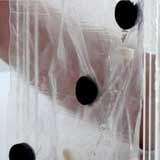Book Materiality in the Architectural Design Studio: Good Practices
Editors: Vaso Trova, Iris Lykourioti
Publisher: Caleidoscopio
The collective volume Materiality in the Architectural Design Studio: Good Practices edited by Vaso Trova and Iris Lykourioti is published in English by Portuguese editorial house Caleidoscopio.
The book concerns the role of materiality in architectural design process and in the practices of architectural education. The chapters included in the volume are contributions by an international group of architects who teach architectural design in various schools across Europe and Turkey. They consist of an interesting and versatile comparative module of teaching experiences and experiments in spatial materialities.
The publication is the outcome of the tutors workshop organized by the Department of Architecture of the University of Thessaly in 2018 focusing on the same subject. The workshop was part of the Department’s international partnership within the EU funded Erasmus+ research program MATERIART.
The digital version of the book (open access) can be downloaded from the following link:
Materiality is a major component in architectural design education. Different methods are used depending on the level of students’ education (introductory year, middle years, final year, post graduate studies), the curriculum and the identity of each architectural school. Students are introduced into the use, aesthetics and mechanics of real materials; they learn how to use materials in symbolic ways in order to represent material reality; they learn how to experiment with non material imageries in order to rethink spatial materiality; they learn the techniques, the social aspects and impacts of material production. Handwork, manufacturing as well as high tech, digitalized material production processes are considered as distinct sets of knowledge to be taken into account likewise. They are equally important for the overall training of students of architecture since they provide a diverse context in the shaping of our material cultures.
In September 2018 the Dept. of Architecture, University of Thessaly organized the Volos Tutors’ Workshop within the framework of MATERIART project. The workshop functioned as a platform of exchange of good teaching practices of different schools of Architecture with regard to the methods used to integrate materiality in architectural studios. During the presentations and the discussions, a variety of methods and tactics have been presented and discussed, ranging from computational design to quick concept modeling.
Materiality as techniques can be understood in terms of the materiality of the final constructed product (a building, a structural detail, an object). A number of participants have shown how the specific restrictions, the potential and the structural properties of materials which are going to be used in the implementation of the project, have to be incorporated into the design processes and therefore shape the final outcome. This doesn’t necessarily mean the subordination of the creative process to a technicalreality. On the contrary, the challenge refers to the negotiation between imagination and technical frameworks and could lead to innovative results. Materials can function as a media isolating and transferring qualities of urban scale to abstract models. They enable us to focus on the specific which is normally interrelated – and therefore hidden- in the interweaved world of urban experience. Materiality could facilitate our way of thinking about certain spatial properties while at the same time it could create ambiguities which force us to reconsider the reality. The visual and the structural aspects of materiality interrelate in the process of understanding the existing and creating the new.
Modelling is a form of thinking, not just a presentation of an idea already completed. The process of design is a continuous negotiation between the abstract thinking and the materiality of the model. In this sense materiality plays a crucial role to the development of the design concept. Models as artefacts are constructing abstract relations between elements (as the sketch in drawing) but instead of lines they are using materials which insert their own properties into the design thinking process. From hands-on explorations to computational design the thinking-making process is heavily based on materiality and the rules imposed by it.
Materials have texture, they create atmospheres, soundscapes, they convey feelings, they formulate physical sensorial experiences. In this sense the poetics of materiality remain an issue which contributes to the design process, either with reference to the materials of the final product or with regard to the materiality of the design process and the thinking-modeling practices.(Introductory text by the editors)

